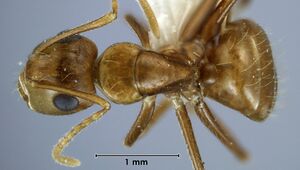Camponotus andyyoungi
| Camponotus andyyoungi | |
|---|---|

| |
| Scientific classification | |
| Kingdom: | Animalia |
| Phylum: | Arthropoda |
| Class: | Insecta |
| Order: | Hymenoptera |
| Family: | Formicidae |
| Subfamily: | Formicinae |
| Tribe: | Camponotini |
| Genus: | Camponotus |
| Species: | C. andyyoungi |
| Binomial name | |
| Camponotus andyyoungi McArthur, 2008 | |
The types workers were collected on sand from Mallee.
Identification
McArthur (2008) - A member of the Camponotus rubiginosiis group (McArthur 2007a) in having similar head and mesosoma forms (in front and lateral view, respectively) but distinguished from other members by its absence of any black colour in the minor workers. Most members of this group possess a distinctive coconut odor but this has not been observed with this species.
Keys including this Species
Distribution
Latitudinal Distribution Pattern
Latitudinal Range: -16.5457° to -33.88333333°.
| North Temperate |
North Subtropical |
Tropical | South Subtropical |
South Temperate |
- Source: AntMaps
Distribution based on Regional Taxon Lists
Australasian Region: Australia (type locality).
Distribution based on AntMaps
Distribution based on AntWeb specimens
Check data from AntWeb
Countries Occupied
| Number of countries occupied by this species based on AntWiki Regional Taxon Lists. In general, fewer countries occupied indicates a narrower range, while more countries indicates a more widespread species. |

|
Estimated Abundance
| Relative abundance based on number of AntMaps records per species (this species within the purple bar). Fewer records (to the left) indicates a less abundant/encountered species while more records (to the right) indicates more abundant/encountered species. |

|
Biology
Castes
   
| |
| . | |
Nomenclature
The following information is derived from Barry Bolton's Online Catalogue of the Ants of the World.
- andyyoungi. Camponotus andyyoungi McArthur, 2008: 113, figs. (w.) AUSTRALIA (South Australia, Western Australia).
- Type-material: holotype minor worker, 3 paratype minor workers.
- Type-locality: holotype Australia: South Australia, Kimba, 33°08’S, 136°25’E, 25.vii.1983 (B.B. Lowery); paratypes with same data.
- Type-depositories: SAMA (holotype); ANIC, NHMW, SAMA (paratypes).
- Status as species: McArthur, 2010: 70; McArthur, 2014: 116.
- Distribution: Australia.
Unless otherwise noted the text for the remainder of this section is reported from the publication that includes the original description.
Description
Worker
Minor. Measurements: HL = 0.78; HW + 0.27 (R2 = 0.82, n = 10); PW = 0.51; HW + 0.25 (R2 = 0.84, n = 10); CW = 0.44; HW - 0.10 (R2 = 0.92, n = 10).
Mesosoma: Dorsum of pronotum, mesonotum and propodeum feebly convex, angle well rounded about 135°, declivity concave, ratio propodeal dorsum / declivity < 1; a few long setae pointing forward on mesosoma; integument on side of mesonotum and propodeum smoothly reticulate, glossy. Node: anterior convex; posterior flat; summit near sharp. Appendages: tibiae with short plentiful setae, inclination to 30°; scapes with plentiful short setae, inclination to 45° Head: a few erect fine setae on under side; setae sparse on head in front view; head sides convex; vertex straight; frontal carinae width < HW/3; maximum head width occurs slightly anterior to eye centre; clypeus anterior margin convex. Colour: reddish yellow.
Type Material
Holotype: One minor worker pinned in South Australian Museum “S.Aust. Kimba 33°08’S 136°25’E Mallee in sand 25/07/1983 B B Lowery” Paratypes: Three minor workers with same data pinned in each of SAMA, Australian National Insect Collection and Naturhistorisches Museum Wien, Vienna.
Type Material
- Holotype, worker, Kimba, 33°08'S 136°25'E, South Australia, Australia, 33°08′0″S 136°25′0″E / 33.133333°S 136.416667°E, South Australian Museum.
- Paratype, 4 workers, Kimba, 33°08'S 136°25'E, South Australia, Australia, 33°08′0″S 136°25′0″E / 33.133333°S 136.416667°E, Lowery,B.B., ANIC32-053468, Australian National Insect Collection.
- Paratype, 3 workers, Kimba, 33°08'S 136°25'E, South Australia, Australia, 33°08′0″S 136°25′0″E / 33.133333°S 136.416667°E, Naturhistorisches Museum Wien, Vienna.
- Paratype, 3 workers, Kimba, 33°08'S 136°25'E, South Australia, Australia, 33°08′0″S 136°25′0″E / 33.133333°S 136.416667°E, South Australian Museum.
Etymology
Named after Andy Young who collects insects for SAMA.
References
- Heterick, B.E. 2021. A guide to the ants of Western Australia. Part I: Systematics. Records of the Western Australian Museum, Supplement 86, 1-245 (doi:10.18195/issn.0313-122x.86.2021.001-245).
- Heterick, B.E. 2022. A guide to the ants of Western Australia. Part II: Distribution and biology. Records of the Western Australian Museum, supplement 86: 247-510 (doi:10.18195/issn.0313-122x.86.2022.247-510).
- McArthur, A. J. 2008. New species of Camponotus (Insecta: Hymenoptera: Formicidae) from Australia. Annalen des Naturhistorischen Museums in Wien. Serie B für Botanik und Zoologie. 109B:111-129.
References based on Global Ant Biodiversity Informatics
- Fisher J., L. Beames, B. J. Rangers, N. N. Rangers, J. Majer, and B. Heterick. 2014. Using ants to monitor changes within and surrounding the endangered Monsoon Vine Thickets of the tropical Dampier Peninsula, north Western Australia. Forest Ecology and Management 318: 7890.

